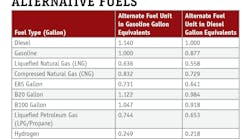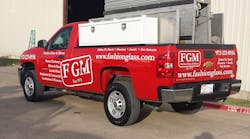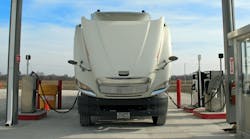Here is a rundown of some of the potential alternative fuel sources to gasoline and diesel for vehicles.
- Natural Gas (NG) – A clean, domestically produced alternative fuel that is an odorless, non-toxic, gaseous mixture of hydrocarbons, predominantly methane. Three forms of natural gas are used in vehicles:
+ Compressed natural gas (CNG) - Natural gas under pressure.
+ Liquefied natural gas (LNG) - Natural gas in its liquid form. Cooling natural gas to about minus 260 degrees F results in the condensation of the gas into a super-cooled (cryogenic) clear, colorless and odorless liquid that is neither corrosive nor toxic.
LNG systems operate at low pressure and can store as much as 2.5 times the fuel in the same space as conventional CNG systems. LNG requires the use of vacuum-insulated storage tanks.
+ Liquefied petroleum gas (LPG), also known as liquid propane gas and autogas – A clean burning, high-energy fuel produced as a by-product of natural gas processing and petroleum refining. At normal temperatures and pressures, LPG will evaporate. Consequently, LPG is stored onboard a vehicle in pressurized tanks.
- Biodiesel – A domestically produced, renewable fuel that can be manufactured from raw vegetable oils, animal fats or recycled restaurant grease for use in diesel-powered vehicles. Biodiesel will often be blended with conventional diesel fuel.
Biodiesel's physical properties are similar to those of petroleum diesel, but it is a cleaner-burning alternative.
- Synthetic Diesel – A fuel that is a blend of synthetically generated hydrocarbons produced from natural gas, coal and organic waste streams, such as biogas.
Synthetic diesel fuels are cleaner burning, have no sulfur content and have a high cetane rating.
A fuel’s cetane number, the rating assigned to diesel fuel to rate its combustion quality, is a measure of the fuel's delay of ignition time – the amount of time between the injection of fuel into the combustion chamber and the actual start of combustion of the fuel charge. A higher cetane number means a shorter ignition delay time and more complete combustion of the fuel charge in the combustion chamber.
Synthetic diesel can be used in existing diesel engines without modifications or mixed with petroleum diesel.
- Ethanol – A renewable, clean-burning, non-fossil fuel made from corn and other plant materials. It can be used as an octane-boosting fuel additive or as a stand-alone fuel.
Almost all gasoline in the U.S. contains some ethanol.
A clear, colorless liquid, ethanol is available as E10 (10 percent ethanol, 90 percent gasoline), E15 (15 percent ethanol, 85 percent gasoline), E85 (85 percent ethanol, 15 percent gasoline) and E100 (100 percent ethanol).
Ethanol has a higher octane rating – the measure of a gasoline’s ability to resist knocking or pinging during combustion – than gasoline.
The higher the octane rating, the greater the fuel’s resistance to engine knocking or pinging, which occurs when the air/fuel mixture detonates prematurely.
Ethanol contains less energy per gallon than gasoline, to varying degrees, depending on the volume percentage of ethanol.
- Electricity – Electricity, drawn directly from an electrical grid and other off-board electrical power sources, and stored in batteries, can be used to power vehicles while lowering fuel costs and reducing emissions.
The main types of electric vehicles are:
+ All electric vehicles (EV), also known as battery electric vehicles (BEV). These use rechargeable batteries to store the electrical energy that powers the electric motor to propel the vehicle. The batteries are charged by plugging the vehicle into an electric power source.
The U.S. EPA categorizes EV as zero-emission vehicles because they produce no direct exhaust or emissions.
+ Hybrid electric vehicles (HEV). These are powered by an internal combustion engine or other propulsion source that can be run on conventional or alternative fuel, and an electric motor that uses energy stored in a battery
HEV cannot plug into off-board sources of electricity to recharge the battery. Rather, they use regenerative braking to capture energy normally lost during braking and the engine to charge the batteries.
The electric motor applies resistance to the drivetrain, causing the wheels to slow down. In return, the energy from the wheels turns the motor, which functions as a generator by converting energy normally wasted during coasting and braking into electricity. This electricity is stored in a battery until needed by the electric motor.
HEV also often have Electric Motor Drive/Assist – the electric motor provides additional power to assist the engine in accelerating, passing or hill climbing – and Automatic Start/Shutoff – the engine automatically shuts off when the vehicle comes to a stop and restarts it when the accelerator is pressed, preventing wasting energy from idling and reducing associated pollution.
+ Plug-in hybrid electric vehicles (PHEV). These are also powered by two energy sources: an internal combustion engine or other propulsion source, and an electric motor which uses energy stored in batteries. These batteries can be charged by plugging into an electrical outlet or charging station, by the internal combustion engine or through regenerative braking.
There are two main configurations of PHEV: series and parallel.
Series PHEV run solely on electricity until the battery needs to be recharged. The engine then generates electricity to power the electric motor.
+ Parallel PHEV connect the engine and the electric motor to the wheels through mechanical coupling, and both are used to directly drive the wheels under most driving conditions. Electric-only operation usually occurs only at low speeds.
- Biogas – A gaseous fuel consisting primarily composed of methane and carbon dioxide, plus small amounts of some other gases. It is derived from rotting municipal waste, food waste or sewage, animal byproducts and agricultural, industrial and municipal solid waste, which is turned into gas by means of anaerobic digestion (decomposition without oxygen).
Biogas is cleaner burning and has characteristics comparable to natural gas. Biogas needs to be stored onboard a vehicle in either a compressed form like CNG or as liquefied form like LNG.
To be used as a vehicle fuel, biogas needs to be processed to purity standards. When it is, it becomes biomethane, also known as renewable natural gas (RNG), and can be used as a substitute for natural gas in natural gas vehicles.
- Dimethyl Ether (DME) – A clean, colorless gas that is handled in liquid form at low pressure. Its properties are similar to those of LPG. DME is degradable in the atmosphere and is not a greenhouse gas.
DME can be derived from a variety of sources, including renewable materials (biomass, waste and agricultural products) and fossil fuels (natural gas and coal). It is primarily produced by converting these materials to synthesis gas (syngas), which is then converted into DME via means of methanol dehydration.
Due to its good ignition quality and a high cetane number, DME can be used in diesel engines as a substitute for conventional diesel fuel. It burns cleanly with no soot.
However, compared to diesel fuel, DME has a lower viscosity and poor lubricity. Some engine modifications are necessary, primarily relating to the injection pump, installation of a pressure tank and special fuel lines.
- Hydrogen – When used in a fuel cell, hydrogen is an emissions-free alternative fuel that can be produced from diverse domestic energy sources. It emits no harmful tailpipe emissions, only heat and water vapor.
Fuel cells convert hydrogen gas stored onboard with oxygen from the air into electricity to drive the electric motor that propels the vehicle.
Hydrogen has a very high energy content by weight – about three times more than gasoline – but it has a very low energy content by volume (liquid hydrogen is about four times less than gasoline).





